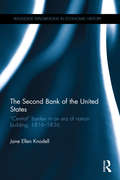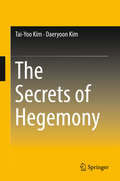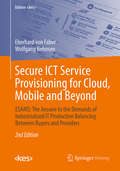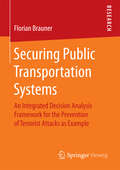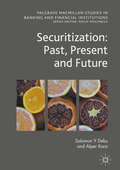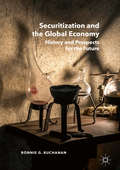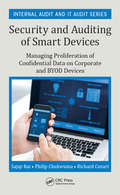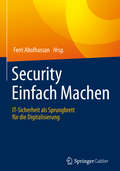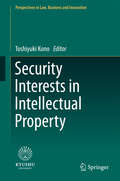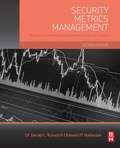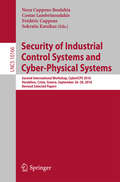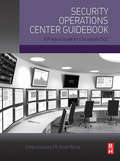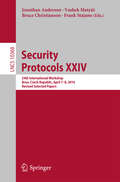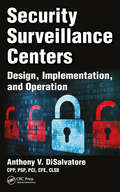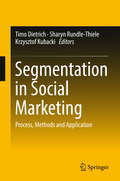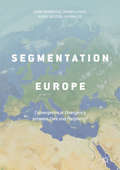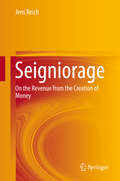- Table View
- List View
The Second Bank of the United States: “Central” banker in an era of nation-building, 1816–1836 (Routledge Explorations in Economic History)
by Jane Ellen KnodellThe year 2016 marks the 200th anniversary of the founding of the Second Bank of the United States (1816-1836). This book is an economic history of an early central bank, the Second Bank of the United States (1816-36). After US President Andrew Jackson vetoed the re-chartering of the Bank in 1832, the US would go without a central bank for the rest of the nineteenth century, unlike Europe and England. This book takes a fresh look at the role and legacy of the Second Bank. The Second Bank of the United States shows how the Bank developed a business model that allowed it to make a competitive profit while providing integrating fiscal services to the national government for free. The model revolved around the strategic use of its unique ability to establish a nationwide system of branches. This book shows how the Bank used its branch network to establish dominance in select money markets: frontier money markets and markets for bills of exchange and specie. These lines of business created synergies with the Bank’s fiscal duties, and profits that helped cover their costs. The Bank’s branch in New Orleans, Louisiana, became its geographic centre of gravity, in contrast with the state-chartered banking system, which was already, by the 1820s, centred around New York. This book is of great interest to those who study banking and American history, as well as economic students who have a great interest in economic history.
The Second Bank of the United States: “Central” banker in an era of nation-building, 1816–1836 (Routledge Explorations in Economic History)
by Jane Ellen KnodellThe year 2016 marks the 200th anniversary of the founding of the Second Bank of the United States (1816-1836). This book is an economic history of an early central bank, the Second Bank of the United States (1816-36). After US President Andrew Jackson vetoed the re-chartering of the Bank in 1832, the US would go without a central bank for the rest of the nineteenth century, unlike Europe and England. This book takes a fresh look at the role and legacy of the Second Bank. The Second Bank of the United States shows how the Bank developed a business model that allowed it to make a competitive profit while providing integrating fiscal services to the national government for free. The model revolved around the strategic use of its unique ability to establish a nationwide system of branches. This book shows how the Bank used its branch network to establish dominance in select money markets: frontier money markets and markets for bills of exchange and specie. These lines of business created synergies with the Bank’s fiscal duties, and profits that helped cover their costs. The Bank’s branch in New Orleans, Louisiana, became its geographic centre of gravity, in contrast with the state-chartered banking system, which was already, by the 1820s, centred around New York. This book is of great interest to those who study banking and American history, as well as economic students who have a great interest in economic history.
A Second Chance for Europe: Economic, Political and Legal Perspectives of the European Union
by Jo RitzenThis book calls upon us to rethink and reboot the European Union. The authors dissect the EU’s many vulnerabilities: how some Member States are backsliding on the rule of law, freedom of the press, and control of corruption – and how globalization’s ‘discontents’ are threatening the liberal international order. It examines the need for a common immigration policy; the need to rethink the unsustainable debt overhang of some Eurozone countries; and the need to use education to foster a European identity. Given the sum total of these vulnerabilities, the book argues, the EU may not survive beyond 2025 in its present form – that is, unless decisive action is taken. In turn, the book puts forward a number of workable solutions: a European economic model to secure full employment; a stronger European Court of Human Rights to counter systemic violations; a points-based immigration policy; clear exit options for the Eurozone; and an Open Education Area with a common second language. These solutions may reduce the number of EU countries, but would increase cohesion and overall survivability.
The Secrets of Hegemony
by Tai-Yoo Kim Daeryoon KimThis book revisits the historically different paths to economic development that Spain, the Netherlands, Great Britain and the United States followed at different time periods since the early modern period. Addressing the questions of how economic growth came about in these four countries and why sustained economic growth was achieved only by the two latter economic powers - Great Britain and the United States, it clearly highlights the long-term economic impact of the individual economic systems each country had developed. This discussion draws on two important variables in economic systems: whether its primary activity is agriculture, commerce, or manufacturing, and whether its productive system expands or simply reproduces. From this interpretive framework, the book suggests that the existing literature has not yet paid sufficient attention to the enduring impact on a nation’s long-term economic performance of their differing economic systems - simple agricultural reproduction system (Spain), expansive commercial reinvestment system (the Netherlands), and expansive industrial reproduction system (Great Britain and the United States). The book also demonstrates why sustained economic growth was viable only within an expansive industrial reproduction system, and what conditions Great Britain and the United States had to fulfill to create such an economic system in their specific historical contexts. It concludes by reflecting on the policy implications of the findings on current discussions concerning economic development within the global economy.
Secure ICT Service Provisioning for Cloud, Mobile and Beyond: ESARIS: The Answer to the Demands of Industrialized IT Production Balancing Between Buyers and Providers (Edition <kes>)
by Eberhard Von Faber Wolfgang BehnsenThis book describes new methods and measures which enable ICT service providers and large IT departments to provide secure ICT services in an industrialized IT production environment characterized by rigorous specialization, standardization and division of labor along the complete supply chain. This book is also for suppliers playing their role in this industry. Even more important, user organizations are given deep insight in secure IT production which allows them to make the best out of cloud, mobile and beyond. This book presents a new organization and classification scheme being thoroughly modular and hierarchical. It contains a security taxonomy that organizes all aspects of modern industrialized IT production. The approach takes operational requirements into account and focuses on user requirements, thus facing the reality in the market economy. Despite cost pressure, providers must ensure security by exploiting economies of scale to raise the efficiency also with respect to security. Furthermore, this book describes a wealth of security measures derived from real-world challenges in IT production and IT service management.
Securing Public Transportation Systems: An Integrated Decision Analysis Framework for the Prevention of Terrorist Attacks as Example
by Florian BraunerFlorian Brauner addresses the risk reduction effects of security measures (SecMe) as well as economic and social effects using terrorist threats in public transportation as use case. SecMe increase the level of security but cause interferences and restrictions for customers (e.g. privacy). This study identifies the interferences and analyzes the acceptance with an empirical survey of customers. A composite indicator for the acceptance of different SecMe is developed and integrated into a risk management framework for multi-criteria decision analysis achieving the right balance of risk reduction, costs, and social acceptance.
Securitization: Past, Present and Future
by Solomon Y Deku Alper KaraThis book aims to explore if and how securitization changed financial intermediation and lending behaviour by reviewing the pre- and post-financial crisis theoretical and empirical literature. The book’s distinctive feature is bringing the growing post-crisis empirical evidence to the attention of a wider audience by critically appraising it against pre-crisis arguments. With its thought-provoking insights, this book is of particular interest for students, practitioners and academics.
Securitization: Past, Present and Future
by Solomon Y Deku Alper KaraThis book aims to explore if and how securitization changed financial intermediation and lending behaviour by reviewing the pre- and post-financial crisis theoretical and empirical literature. The book’s distinctive feature is bringing the growing post-crisis empirical evidence to the attention of a wider audience by critically appraising it against pre-crisis arguments. With its thought-provoking insights, this book is of particular interest for students, practitioners and academics.
Securitization and the Global Economy: History and Prospects for the Future
by Bonnie G. BuchananThis book examines the controversial issue of securitization in a global, historical context. It traces its origins and compares evidence of securitization across countries, linking differences to variations in legal, political, and cultural regimes. By incorporating the history and current status of securitization (including sources of value and risk) with alternative markets and future outlooks for the global market, Buchanan provides an overall assessment of the costs, benefits, and sustainability of securitization in the global economy, particularly in the aftermath of the 2007-2009 financial crisis. The book also offers a roadmap for future research. As financial regulators around the world plan a sweeping overhaul of securitization markets with tough new rules designed to restore market confidence, it is essential to consider the global outlook for securitization.
Security and Auditing of Smart Devices: Managing Proliferation of Confidential Data on Corporate and BYOD Devices (Security, Audit and Leadership Series)
by Sajay Rai Philip Chukwuma Richard CozartMost organizations have been caught off-guard with the proliferation of smart devices. The IT organization was comfortable supporting the Blackberry due to its ease of implementation and maintenance. But the use of Android and iOS smart devices have created a maintenance nightmare not only for the IT organization but for the IT auditors as well. This book will serve as a guide to IT and Audit professionals on how to manage, secure and audit smart device. It provides guidance on the handling of corporate devices and the Bring Your Own Devices (BYOD) smart devices.
Security and Auditing of Smart Devices: Managing Proliferation of Confidential Data on Corporate and BYOD Devices (Security, Audit and Leadership Series)
by Sajay Rai Philip Chukwuma Richard CozartMost organizations have been caught off-guard with the proliferation of smart devices. The IT organization was comfortable supporting the Blackberry due to its ease of implementation and maintenance. But the use of Android and iOS smart devices have created a maintenance nightmare not only for the IT organization but for the IT auditors as well. This book will serve as a guide to IT and Audit professionals on how to manage, secure and audit smart device. It provides guidance on the handling of corporate devices and the Bring Your Own Devices (BYOD) smart devices.
Security Einfach Machen: IT-Sicherheit als Sprungbrett für die Digitalisierung
by Ferri AbolhassanIn diesem Buch beleuchten Autoren aus der Politik, Wirtschaft und Forschung das Thema Security: Was wird sie kosten und wer wird sie anbieten? Wird Security vielleicht sogar Spaß machen? Das Internet der Dinge wird nicht einmal zehn Jahre brauchen, um 2020 mehr als 50 Milliarden Geräte zu vernetzen. Digitalisierung rast durch alle Bereiche der Wirtschaft und des Lebens. Sie bringt Geschwindigkeit und Kosteneffizienz, aber sie vergrößert auch unsere Angriffsfläche – der Menschen und unserer Unternehmen. Im Ergebnis wird erst Security zum Möglichmacher sicherer Digitalisierung, in der Daten, Netze, Rechenzentren und Endgeräte künftig maximal möglich geschützt werden. Security muss in Zukunft ganz einfach zu bedienen sein. Und zwar für alle: vom Rentner über die Hausfrau und den Studenten bis zum Mittelstand und Großunternehmen.
Security Interests in Intellectual Property (Perspectives in Law, Business and Innovation)
by Toshiyuki KonoEconomic development increasingly depends to a large extent on innovation. Innovation is generally covered by intellectual property (IP) rights and usually requires extensive funding. This book focuses on IP and debt financing as a tool to meet this demand. This book clarifies the situation of the use of IP as collateral in practice through a survey conducted in Japan on IP and debt financing. Various obstacles in the proper use IP and debt financing are identified, and some projects to facilitate its use are illustrated. IP and debt on a global scale, either by attracting foreign lenders or by collateralizing foreign IP rights, needs appropriate private international laws. This book analyzes such regulations in which the United Nations Commission on International Trade Law (UNCITRAL) has worked, paying due attention to the law of finance and insolvency law, as well as IP laws. However, further analysis is needed to identify under what conditions such solutions would show optimal effects. This book offers comprehensive analysis from an economic point of view.
Security Metrics Management: Measuring the Effectiveness and Efficiency of a Security Program
by Gerald L. Kovacich Edward HalibozekSecurity Metrics Management, Measuring the Effectiveness and Efficiency of a Security Program, Second Edition details the application of quantitative, statistical, and/or mathematical analyses to measure security functional trends and workload, tracking what each function is doing in terms of level of effort (LOE), costs, and productivity. This fully updated guide is the go-to reference for managing an asset protection program and related security functions through the use of metrics. It supports the security professional’s position on budget matters, helping to justify the cost-effectiveness of security-related decisions to senior management and other key decision-makers. The book is designed to provide easy-to-follow guidance, allowing security professionals to confidently measure the costs of their assets protection program - their security program - as well as its successes and failures. It includes a discussion of how to use the metrics to brief management, build budgets, and provide trend analyses to develop a more efficient and effective asset protection program.Examines the latest techniques in both generating and evaluating security metrics, with guidance for creating a new metrics program or improving an existing oneFeatures an easy-to-read, comprehensive implementation plan for establishing an asset protection programOutlines detailed strategies for creating metrics that measure the effectiveness and efficiency of an asset protection programOffers increased emphasis through metrics to justify security professionals as integral assets to the corporationProvides a detailed example of a corporation briefing for security directors to provide to executive management
Security of Industrial Control Systems and Cyber-Physical Systems: Second International Workshop, CyberICPS 2016, Heraklion, Crete, Greece, September 26-30, 2016, Revised Selected Papers (Lecture Notes in Computer Science #10166)
by Nora Cuppens-Boulahia Costas Lambrinoudakis Frédéric Cuppens Sokratis KatsikasThis book constitutes the refereed proceedings of the Second Conference on Security of Industrial Control Systems and Cyber-Physical Systems, CyberICPS 2016, held in Crete, Greece, in September 2016 in conjunction with ESORICS 2016, the 21st annual European Symposium on Research in Computer Security. The 5 revised full papers 2 invited papers presented were carefully reviewed and selected from 18 initial submissions. CyberICPS 2016 focuses on topics related to the management of cyber security in industrial control systems and cyber-physical systems, including security monitoring, trust management, security policies and measures.
Security Operations Center Guidebook: A Practical Guide for a Successful SOC
by Gregory Jarpey Scott MccoySecurity Operations Center Guidebook: A Practical Guide for a Successful SOC provides everything security professionals need to create and operate a world-class Security Operations Center. It starts by helping professionals build a successful business case using financial, operational, and regulatory requirements to support the creation and operation of an SOC. It then delves into the policies and procedures necessary to run an effective SOC and explains how to gather the necessary metrics to persuade upper management that a company’s SOC is providing value. This comprehensive text also covers more advanced topics, such as the most common Underwriter Laboratory (UL) listings that can be acquired, how and why they can help a company, and what additional activities and services an SOC can provide to maximize value to a company. Helps security professionals build a successful business case for a Security Operations Center, including information on the necessary financial, operational, and regulatory requirementsIncludes the required procedures, policies, and metrics to considerAddresses the often opposing objectives between the security department and the rest of the business with regard to security investmentsFeatures objectives, case studies, checklists, and samples where applicable
Security Protocols XXIV: 24th International Workshop, Brno, Czech Republic, April 7-8, 2016, Revised Selected Papers (Lecture Notes in Computer Science #10368)
by Jonathan Anderson Vashek Matyáš Bruce Christianson Frank StajanoThis book constitutes the thoroughly refereed post-workshop proceedings of the 24 th International Workshop on Securit Protocols, held in Brno, Czech Republic, in April 2016. The 13 thoroughly revised papers presented together with the respective transcripts of discussions have been carefully reviewed. The theme of the workshop was Evolving Security - considering that security protocols evolve with their changing requirements, their changing mechanisms and attackers' changing agendas and capabilities.
Security Surveillance Centers: Design, Implementation, and Operation
by Anthony V. DiSalvatoreUnlike current books on the market that focus primarily on the technical aspects of surveillance and protection, Security Surveillance Centers: Design, Implementation, and Operation focuses on the operation of a security surveillance center. This text explains in detail the role of security surveillance, as well as the critical aspects of the design, implementation, and operation of security surveillance centers of all sizes. Step-by-step coverage of policy and procedures, as well as the inclusion of industry-specific operational forms, guarantee a practical, user-friendly text for all levels of readers. Intended for any individuals or organizations currently employing security surveillance systems, this book is an asset for all users, from trainees to supervisors, seeking to create a more secure environment for themselves and for others.
Security Surveillance Centers: Design, Implementation, and Operation
by Anthony V. DiSalvatoreUnlike current books on the market that focus primarily on the technical aspects of surveillance and protection, Security Surveillance Centers: Design, Implementation, and Operation focuses on the operation of a security surveillance center. This text explains in detail the role of security surveillance, as well as the critical aspects of the design, implementation, and operation of security surveillance centers of all sizes. Step-by-step coverage of policy and procedures, as well as the inclusion of industry-specific operational forms, guarantee a practical, user-friendly text for all levels of readers. Intended for any individuals or organizations currently employing security surveillance systems, this book is an asset for all users, from trainees to supervisors, seeking to create a more secure environment for themselves and for others.
Segeln auf Sicht: Das Führungshandbuch für ungewisse Zeiten
by Olaf HinzMit 11 Konzepten hilft Ihnen dieses Handbuch, Ihr Führungsrepertoire zu erweitern und bewährte Tools zu ergänzen, um im Führungsalltag zu bestehen. In einer komplexen Welt kann es kein neues, einziges und überragendes Führungsparadigma mehr geben: Es geht um mehrere Optionen. Segeln auf Sicht ist die angemessene Reaktion auf die zunehmende Veränderungsgeschwindigkeit und Sturmgewalten in der heutigen Managementwelt, deren Paradigmen sich geändert haben.
Segmentation in Social Marketing: Process, Methods and Application
by Timo Dietrich Sharyn Rundle-Thiele Krzysztof KubackiThis book brings together current innovative methods and approaches to segmentation and outlines why segmentation is needed to support more effective social marketing program design. It presents a variety of segmentation approaches alongside case studies of their application in various social marketing contexts. The book extends the use of segmentation in social marketing, which will ultimately lead to more effective and better-tailored programs that deliver change for the better. As such, it offers a detailed handbook on how to conduct state-of-the-art segmentation, and provides a valuable resource for academics, social marketers, educators, and advanced students alike.
The Segmentation of Europe: Convergence or Divergence between Core and Periphery?
by Mark Baimbridge Ioannis Litsios Karen Jackson Uih Ran LeeThis book explores economic developments across Europe in relation to its apparent segmentation, as disparities widen between core and periphery countries. In contrast to previous literature, the scope of analysis is extended to Europe as a continent rather than confining it solely to the European Union, thereby providing the reader with greater insight into the core/periphery nexus. The authors commence with a critical appraisal of economic thinking in relation to regional trade agreements and monetary integration. In relation to a number of EU economies, the book addresses issues of a liquidity trap, deflation, and twin deficits, together with the interconnection between exchange rates and current account balances. Importantly, they extend the discussion of segmentation through a series of focused case studies on Russia, Brexit and emergence of the mega-regionals.
Seigniorage: On the Revenue from the Creation of Money
by Jens ReichThis book analyzes the revenues from the creation of currency by a central government. Adopting an institutional perspective, it develops a general theory of seigniorage by identifying three monetary regimes in economic history and the history of economic thought: a commodity currency, a fiat currency and a credit currency regime. As such it provides a modern analytical framework to analyze the nature of revenues from the creation of currency and their optimal height, whether currency is issued by means of minting coins, by printing and spending paper notes, by crediting private entities, or combinations thereof. The results of this analysis stretch beyond the immediate topic. The book establishes a relationship between the theory of seigniorage and government debt, the theory of the interest rate, the optimal rate of inflation, or the effectiveness and inflationary limits of outright monetary transactions.
Seismic Isolation for Architects
by Andrew Charleson Adriana GuisasolaSeismic isolation offers the highest degree of earthquake protection to buildings and their inhabitants. Modern applications of the technology are less than 50 years old and uptake in seismically active regions continues to soar. Seismic Isolation for Architects is a comprehensive introduction to the theory and practice in this field. Based on the latest research findings and the authors’ extensive experience, coverage includes the application, effectiveness, benefits, and limitations of seismic isolation, as well as the architectural form, design aspects, retrofitting, economics, construction, and maintenance related to this method. The book is written for an international audience: the authors review codes and practices from a number of countries and draw on examples from eleven territories including the US, Chile, Argentina, Italy, Japan, and New Zealand. Aimed at readers without prior knowledge of structural engineering, the book provides an accessible, non-technical approach without using equations or calculations, instead using over 200 drawings, diagrams and images to support the text. This book is key reading for students on architecture and civil engineering courses looking for a clear introduction to seismic-resistant design, as well as architects and engineers working in seismically active regions.
Seismic Isolation for Architects
by Andrew Charleson Adriana GuisasolaSeismic isolation offers the highest degree of earthquake protection to buildings and their inhabitants. Modern applications of the technology are less than 50 years old and uptake in seismically active regions continues to soar. Seismic Isolation for Architects is a comprehensive introduction to the theory and practice in this field. Based on the latest research findings and the authors’ extensive experience, coverage includes the application, effectiveness, benefits, and limitations of seismic isolation, as well as the architectural form, design aspects, retrofitting, economics, construction, and maintenance related to this method. The book is written for an international audience: the authors review codes and practices from a number of countries and draw on examples from eleven territories including the US, Chile, Argentina, Italy, Japan, and New Zealand. Aimed at readers without prior knowledge of structural engineering, the book provides an accessible, non-technical approach without using equations or calculations, instead using over 200 drawings, diagrams and images to support the text. This book is key reading for students on architecture and civil engineering courses looking for a clear introduction to seismic-resistant design, as well as architects and engineers working in seismically active regions.
